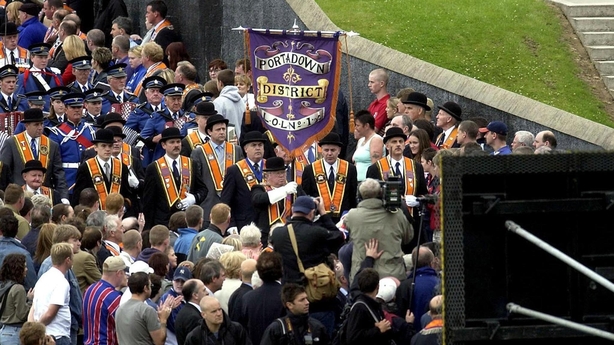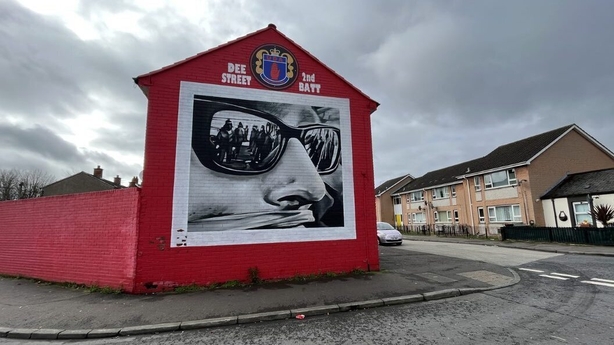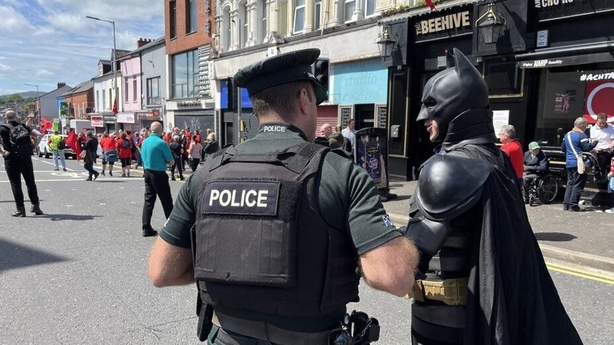Tourists have a huge appetite for the history of the Troubles.
They come from across the world to write messages on Belfast's peace walls.
Around 60 such walls still separate Catholic and Protestant communities in Belfast.
The biggest is at Cupar Way, separating the Falls and Shankill districts.
When the British military put up a barbed wire barrier there in the late 1960s it was meant to be there for months, a temporary structure until community tensions eased.
An army officer quoted at the time said he did not want another Berlin Wall in Western Europe.
More than 50 years later, it is still standing - strengthened, lengthened, heightened.
Around 60 peace walls still separate Catholic and Protestant communities in Belfast. This University of Ulster academic says they are a symbol of the division that still exists in Northern Ireland, with more work needed to tackle issues in the communities around them pic.twitter.com/9e7jxC57jA
— RTÉ News (@rtenews) April 6, 2023
University of Ulster academic Dr Jonny Byrne has studied the walls. He says they are the symbol of unresolved issues from the conflict and wider sectarianism that still permeates Northern Ireland.
"The walls themselves are a very complicated issue. A lot of people just focus on the walls but actually, we need to look at the communities around them.
"We need to look at issues around education, unemployment, suicide, drug and alcohol abuse which all exist within these areas and the walls are a symptom of this.
"So to simply focus on the walls is actually to miss the point. We need to look at a broader, more complex reconciliation process."

Orange Order parades used to be a huge cause of community division.
In the late 1990s and for years afterwards, a disputed march from Drumcree Parish Church near Portadown meant an annual confrontation.
Some people died in the murderous tension that surrounded it.
But eventually, the Orange Order was faced down there and elsewhere.
It still protests at Drumcree Church every week, but now it is more of a Sunday stroll than the huge rallies of the past.
It is a measure of how much things have changed.
But restrictions on parades still rankle with unionists and loyalists who say they are an example of how their culture has been compromised.

Paramilitaries played a role in the Drumcree dispute and they are active in both communities to this day.
Dissident republicans want to maintain a campaign of violence, their operational capacity, while limited, has the potential to be lethal.
In loyalist areas, some paramilitaries stepped back, but many morphed into criminal gangs deeply involved in drugs.
A measure of control is exerted through so-called punishment shootings and beatings.
In 2022 there were 37 such casualties in both communities.
Monica McWilliams is a signatory to the Good Friday Agreement.
She now sits on the Independent Reporting Commission which monitors paramilitary activity.
It advocates robust policing of criminality in such communities, alongside support for projects seeking to divert young people from the ranks of paramilitaries.
"There are great young community leaders and youth workers out there at the minute.
"That is why when the outbreak of violence and buses were burned a couple of years ago it was not everywhere in Northern Ireland.
"Yes, the international media came and took pictures which wasn't great for future investment."
She says: "But what people didn't see were the youth workers and community workers going round knocking doors and saying to mothers 'Get Johnny back in, he's going to school in the morning, he's not going to the Young Offenders' Centre'. They are the real peacemakers in my book."
Policing is widely acknowledged as one of the success stories of the peace process, the Police Service of Northern Ireland replaced the Royal Ulster Constabulary.

It went from a police force to a police service which is now much more representative of the community it aims to protect.
A new name, new symbols and a style of community policing underpinned by human rights legislation make it unrecognisable from what went before.
Debbie Watters sees the new reality every day of the week.
A former vice chair of Northern Ireland's Policing, she now works in a community justice project to promote non-violent community responses to anti-social behaviour.
She says: "We have a service now which is much more representative of the community. When the Good Friday Agreement was signed about 8% of the RUC were Catholics. Now we have just over 30%."
Ms Watters added: "We have a way to go, we have just under 30% female as well. There's work to be done but actually, we now have a service that is more representative and looks much more like the community that it serves."
Much has changed in Northern Ireland. Some things have not.
The true success of the Good Friday Agreement is that it stopped people from being murdered.
Some estimate there could be 2,000 people walking the streets today who would be dead but for the peace accord.
That is something worth celebrating, but peace is a work in progress.







